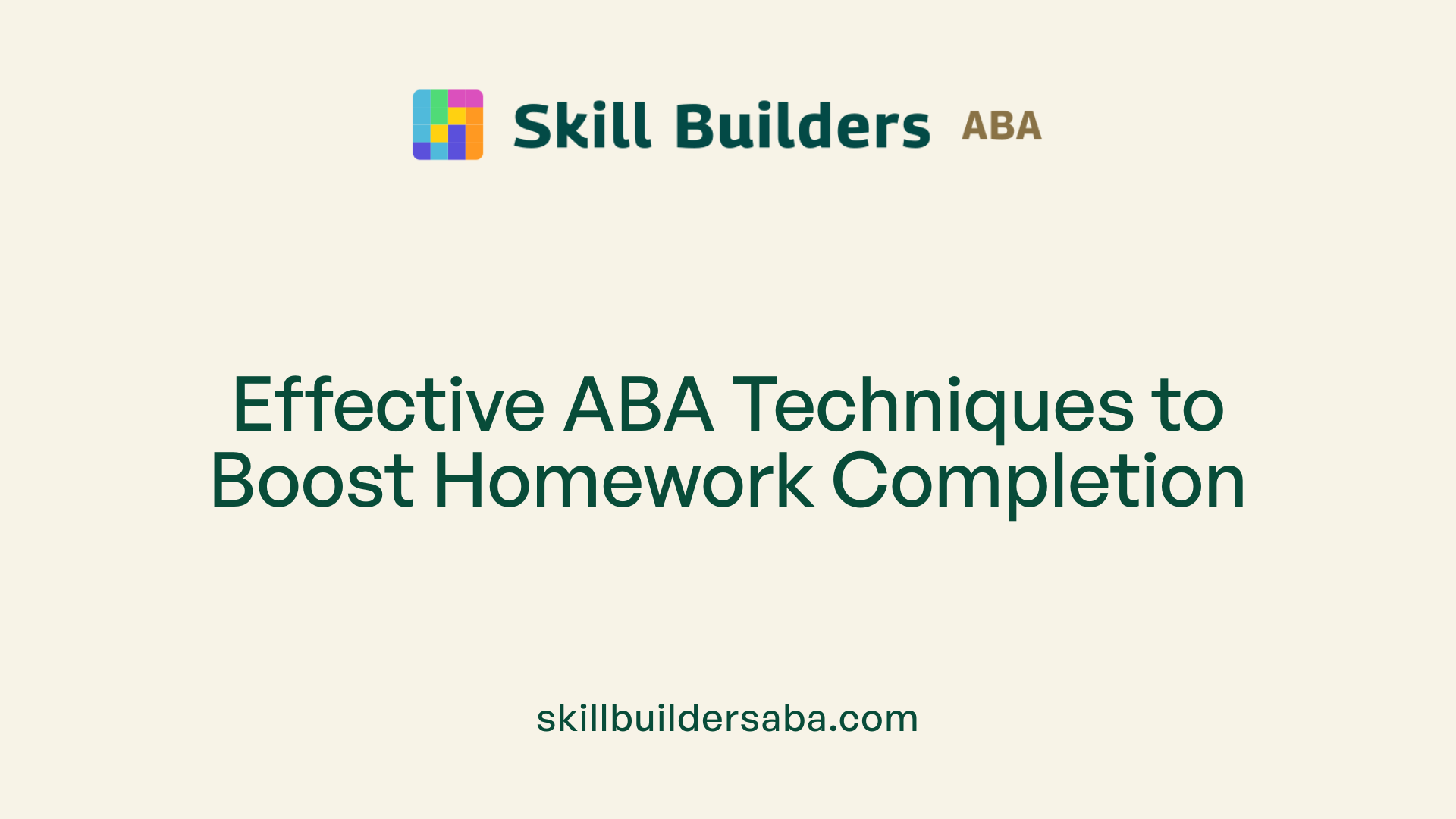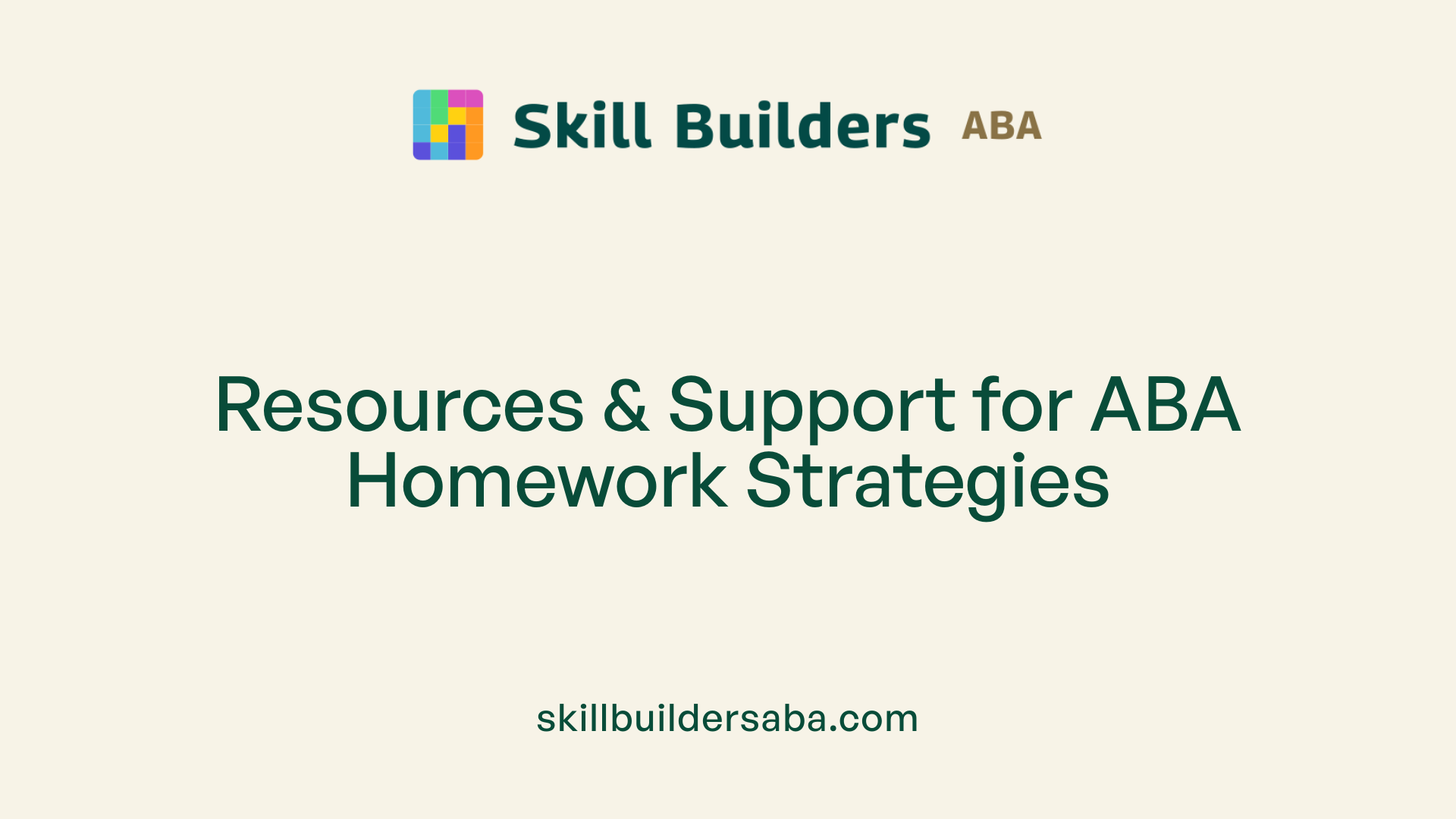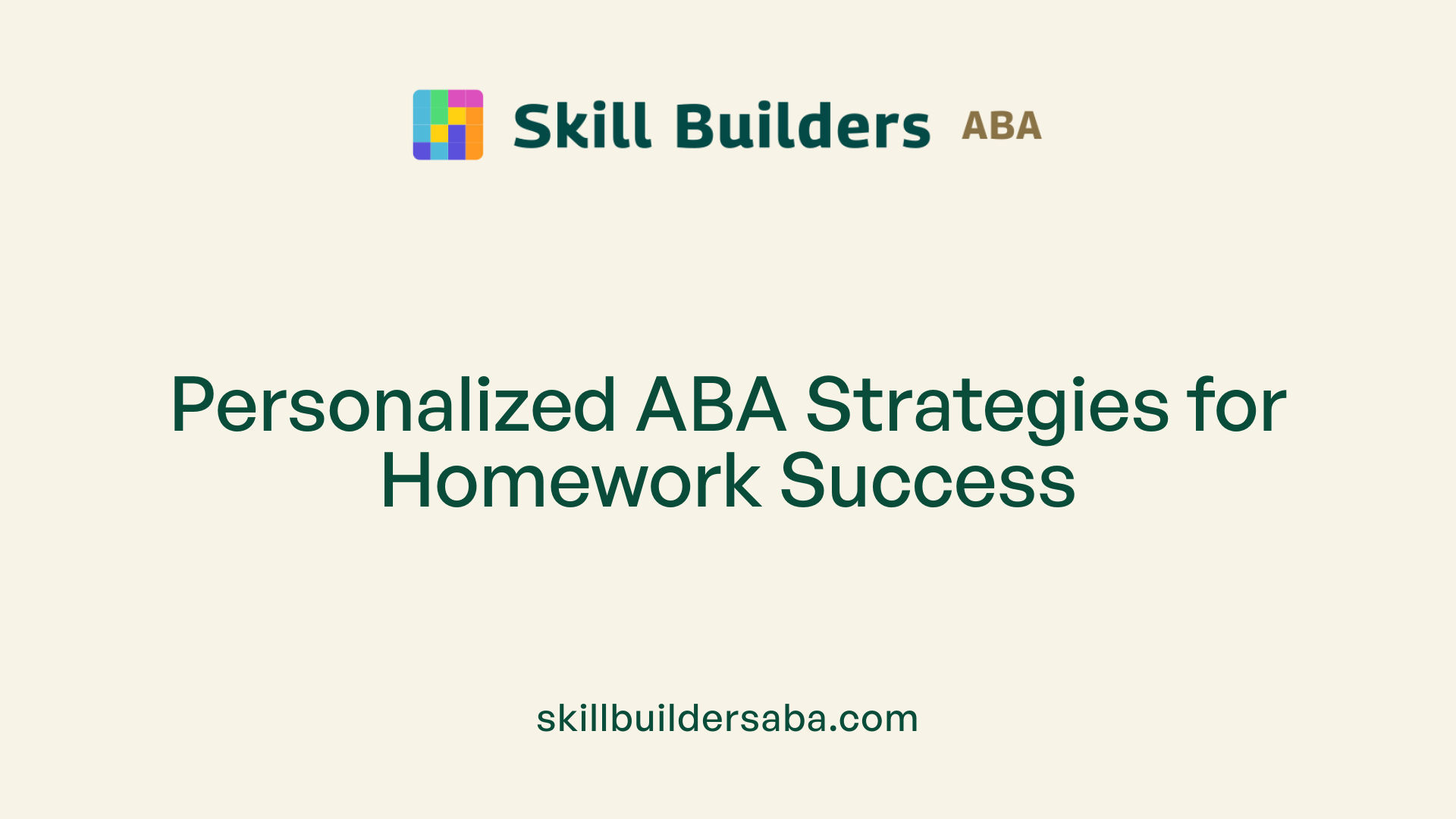
Using ABA to support homework completion
Strategies for Enhancing Homework Completion with ABA
Unlocking the Potential of ABA in Educational Settings
Applied Behavior Analysis (ABA) offers a structured, evidence-based approach suited for supporting children, particularly those with ASD, in completing homework tasks successfully. By integrating principles like positive reinforcement, visual supports, and structured routines, educators and parents can create an environment conducive to focused learning. This article explores effective ABA techniques, practical implementation strategies in schools, available resources, and tailored support for children with ASD to foster independence and confidence in homework completion.
Core ABA Techniques to Facilitate Homework Completion

What are effective ABA techniques to support homework completion?
Supporting children with ABA in completing homework involves a variety of strategies designed to promote independence and reduce anxiety. One of the most fundamental methods is positive reinforcement. This technique rewards children with praise, tokens, or other rewards when they successfully complete parts of their homework, encouraging them to repeat these behaviors.
Another important approach is task analysis. This involves breaking down complex homework tasks into smaller, manageable steps. For example, if a child needs to write a paragraph, the steps might include reading the instructions, brainstorming ideas, writing a rough draft, revising, and finalizing the work. Structuring tasks this way can reduce feelings of being overwhelmed and help children stay focused.
Visual supports also play a significant role. Tools like visual checklists, schedules, and cue cards clarify what needs to be done, providing visual cues that support independence. Visual aids help children understand and organize their tasks, making homework less daunting.
Creating a structured and distraction-free environment enhances concentration. This can include using a quiet space, establishing a consistent routine, and limiting electronic distractions like phones or games. Environmental adjustments like noise-canceling headphones or a designated study corner can reduce interruptions.
Prompting and fading techniques are used to teach new skills and encourage independence. Initially, prompts such as verbal hints or physical guidance help children begin tasks. Over time, these prompts are gradually faded to promote autonomous completion.
Finally, teaching self-monitoring strategies empowers children to track their own progress and recognize when they need help. This could involve checklists, timers, or self-assessment forms, fostering a sense of responsibility and confidence.
Incorporating these ABA methods creates a supportive framework that helps children develop successful homework habits, enhances their skills, and builds confidence in their abilities.
Implementing ABA in School Settings for Homework Support

How can ABA principles be implemented in school settings to facilitate homework completion?
Applied Behavior Analysis (ABA) introduces effective strategies into the classroom that help children with Autism Spectrum Disorder (ASD) succeed with homework. One fundamental approach is the use of positive reinforcement. When students complete homework tasks, they are rewarded with praise, tokens, or other preferred items, which encourages them to repeat these behaviors.
Visual supports are also vital. Tools like visual checklists, graphic organizers, and timers help students understand what needs to be done and manage their time efficiently. These supports can reduce anxiety by providing clear expectations, fostering a sense of predictability crucial for children with ASD.
Structured routines create a predictable environment where students know what to expect. Consistently applying clear expectations and routines helps make homework tasks feel more manageable, increasing the likelihood of successful completion.
Collaboration is essential for effective implementation. Teachers, therapists, and families work together to develop individualized strategies tailored to each child's needs. Sharing insights and progress allows for adjustments that ensure interventions are consistent across settings.
Ongoing data collection is critical for monitoring a child's progress. Regular assessment of behaviors and task completion helps determine what strategies are effective, enabling continuous refinement of support plans.
Finally, equipping teachers with training in ABA techniques empowers them to incorporate these strategies confidently. When educators understand how to use reinforcement, visuals, and routines effectively, they can better support students, increasing motivation and independence in completing homework.
Resources and Support Systems for Applying ABA in Homework Support
 There are many useful resources that help educators and parents apply ABA techniques to improve homework completion for children with ASD and behavioral challenges.
There are many useful resources that help educators and parents apply ABA techniques to improve homework completion for children with ASD and behavioral challenges.
Educational resources such as online guides, toolkits, and curriculum materials are often provided by reputable organizations like the IRIS Center, which focus on evidence-based practices. These resources include strategies like positive reinforcement, visual schedules, token systems, and offering choices, all aimed at increasing motivation and independence.
Professional training programs are available to enhance understanding and implementation of ABA principles. These programs typically cover behavior management strategies, skill development techniques, and ways to adapt interventions for individual needs. Such training ensures practitioners can deliver consistent and effective support both at school and home.
Lesson planning tools designed with ABA principles assist teachers in structuring activities that promote skill acquisition. These tools help in breaking tasks into smaller, manageable steps and integrating reinforcement methods seamlessly into daily routines.
Evidence-based practices emphasize the importance of consistency, reinforcement, and generalization, ensuring skills learned in one setting carry over to others. Resources that focus on these practices support the development of personalized and adaptable interventions.
Below is a summary table of common resources and their primary focus areas:
| Resource Type | Purpose | Key Features |
|---|---|---|
| Online guides & curriculum | Teaching ABA techniques & strategies | Visual supports, reinforcement methods, behavior strategies |
| Professional training programs | Building practitioner expertise | Hands-on workshops, certification programs |
| Lesson planning tools | Planning effective ABA-based lessons | Step breakdowns, reinforcement integration |
| Evidence-based practice databases | Supporting consistent strategies | Research-backed methods, case studies |
Accessing these tools and strategies enables both educators and parents to foster a supportive environment that enhances homework compliance and skill development for children engaging in ABA therapy.
Tailoring ABA Strategies for Children with Autism Spectrum Disorder

How can ABA therapy be used to assist children with ASD in completing their homework?
ABA therapy offers personalized approaches to help children with ASD develop the skills needed for successful homework completion. Trained professionals, like BCBAs, design intervention plans that focus on building foundational skills such as task initiation, attention, and self-monitoring. They use techniques such as task analysis, which breaks down homework tasks into smaller, manageable steps, making it easier for children to understand and complete each part.
Positive reinforcement plays a vital role in encouraging children to stay motivated. Praising efforts, providing rewards, and celebrating successes bolster confidence and promote continued effort. Visual supports, such as schedules, graphic organizers, and visual aids, help children understand what is expected and organize their work effectively.
Structured routines and clear instructions—like short sentences and checklists—reduce anxiety and create predictability, which is particularly helpful for children with ASD. Incorporating interests and strengths into homework activities further enhances engagement, making learning more enjoyable.
ABA programs are tailored to each child's unique needs. Regular assessments by professionals ensure that strategies evolve and address emerging challenges. Collaboration among parents, teachers, and therapists guarantees consistency across settings.
In addition to skill-building, ABA helps address specific behaviors that may hinder homework completion, such as distractibility or difficulty following directions. By teaching self-advocacy skills, children learn to communicate when they need help, promoting independence.
Technology aids, like speech-to-text apps and visual schedule software, further support children in managing their work efficiently. Overall, ABA therapy fosters not only better homework outcomes but also confidence and independence in children with ASD.
The Role of Reinforcement and Skill Generalization in Homework Success

What are effective ABA techniques to support homework completion?
ABA therapy offers practical strategies to help children with ASD succeed in their homework routines. One of the most important methods is positive reinforcement. This involves praising efforts, giving rewards, or celebrating small successes to motivate children to stay engaged.
Breaking down tasks is another vital technique. Using task analysis, complex homework assignments are divided into smaller, manageable steps. This approach reduces feelings of being overwhelmed and helps children focus on one part at a time.
Visual supports also play a crucial role. Tools like checklists, visual schedules, and pictorial cues clarify what needs to be done, making tasks more predictable and easier to follow.
Creating a structured environment is essential. Establishing consistent routines, limiting distractions such as electronic devices, and using environmental strategies like noise-canceling headphones can boost attention and decrease interruptions.
Additional techniques include prompting, using cues to encourage specific actions, and gradually fading these prompts so the child gains independence.
Teaching self-monitoring strategies also helps children track their progress and stay motivated. These combined approaches foster an atmosphere where children can build confidence and independence in completing their homework.
How does reinforcement play into behavioral systems?
Reinforcement in ABA involves rewarding desired behaviors to increase their likelihood. For homework support, this might mean giving immediate praise or small rewards when a child completes a task or follows directions. These consistent positive responses help establish good habits and reinforce the importance of effort.
Implementing a reward system tailored to the child's interests can significantly boost motivation. For example, earning tokens toward a preferred activity encourages continued effort and persistence.
Why is generalization across environments important?
Generalization refers to applying learned skills in different settings, such as at home or in the classroom. ABA emphasizes teaching skills in a way that children can transfer them across environments.
Practicing homework routines in various contexts helps ensure that children don’t only perform well during therapy sessions but can also independently complete assignments at home and school.
How can building independence enhance homework success?
Supporting children in becoming more independent involves teaching them to initiate tasks, use visual supports, and self-monitor their work. This autonomy reduces reliance on prompts and encourages ownership of their learning process.
Self-advocacy skills, like asking for help when needed, are also vital. When children learn to communicate their needs effectively, they’re more likely to stay engaged and succeed with homework.
Combining reinforcement, consistent routines, and skill generalization creates a comprehensive approach, helping children with ASD develop successful homework habits and greater independence.
Creating Homes and Schools that Support ABA-Driven Homework Completion

How can ABA therapy be used to assist children with ASD in completing their homework?
ABA therapy offers tailored strategies to help children with ASD succeed in their homework routines. It focuses on building skills like starting tasks, maintaining attention, and self-monitoring, all crucial for independent work.
One effective method is positive reinforcement. Praising effort and providing rewards motivate children to stay engaged with their assignments, making homework feel more manageable and less overwhelming.
Using visual supports such as schedules, graphic organizers, and visual cues helps children understand what to do next and stay organized. These tools break down tasks into smaller, clear steps, which can be easier for children to follow.
Implementing structured routines creates predictability, reducing anxiety and helping children transition smoothly between activities. Consistent routines at home and school reinforce behaviors and foster independence.
ABA programs are personalized, meaning professionals like Board Certified Behavior Analysts (BCBAs) continually assess and adjust strategies to meet each child's evolving needs. Collaboration with teachers and parents ensures that techniques are aligned and consistently applied.
Addressing disruptive or challenging behaviors is also part of the process. ABA helps teach children appropriate ways to express needs and cope, which supports focused work and reduces interruptions.
In summary, ABA therapy combines positive reinforcement, visual supports, structured routines, and ongoing assessment to empower children with ASD to complete their homework with confidence, independence, and motivation.
Empowering Students Through ABA-Driven Homework Strategies
Integrating ABA principles into homework routines enhances children’s ability to complete assignments successfully, fostering independence, motivation, and confidence. Customized interventions—such as visual supports, positive reinforcement, structured routines, and collaboration among educators, therapists, and families—create a consistent, supportive environment that addresses individual needs. As research continues to affirm the effectiveness of ABA in educational settings, caregivers and educators are encouraged to utilize these strategies to maximize learning outcomes for children with ASD and other behavioral challenges. With ongoing support and tailored approaches, children can develop essential skills that extend beyond homework, paving the way for lifelong success.
References
- School-based ABA Therapy in Colorado
- 7 Strategies for Homework Success with Children with ASD
- 11 Ways to Incorporate ABA Principles in Your Daily Life
- ABA Therapy Approach to Enhancing Focus and Reducing ...
- Top ABA Therapy Techniques for Parents - Little Rays ABA
- 9 Proactive ABA Methods to Redirect Student Behavior
- Supporting Your Child's ABA Therapy at Home: A Parent's Guide
- School-Based ABA Therapy: Boosting Learning and Behavior
- How to Use ABA in the Classroom
Trusted Support at Your Fingertips
Discover how Skill Builders ABA can support your family’s unique path by browsing our online resources. If you have specific concerns and want to speak to a human, please contact us directly for a consultation.
Reach Out Today
Learn more about how we can support your child’s growth and development. Contact us to discuss our services and availability in your area.
.svg)